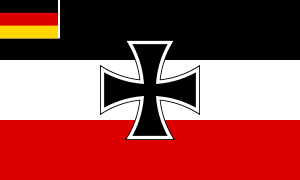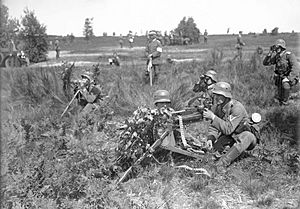Reichswehr facts for kids
The Reichswehr (pronounced RYKES-vayr) was the name for Germany's military from 1919 to 1935. Its name means "Realm Defence" in English. It was created after World War I and later became part of the new Wehrmacht (Defence Force).
Quick facts for kids Realm DefenceReichswehr |
|
|---|---|
|
War Ensign of the Reichswehr |
|
| Established | 19 January 1919 |
| Disbanded | 16 March 1935 |
| Parts |
|
| Headquarters | Zossen, near Berlin |
| Leadership | |
| Commander-in-chief | Friedrich Ebert (1919–25) Paul von Hindenburg (1925–34) Adolf Hitler (1934–35) |
| Minister of Defence | See list |
| Chief of the Troop Office | See list |
| Serving soldiers | |
| Military age | 18–45 |
| Conscription | No |
| Active employees/soldiers | 115,000 (1921) |
| See also | |
| History | German Revolution Silesian Uprisings Suppression of the Beer Hall Putsch Ruhr Uprising Kapp Putsch (limited support) |

Contents
How the Reichswehr Was Formed
After World War I ended, Germany's old army was broken up. Many soldiers went home. Some joined groups called Freikorps (Free Corps). These were volunteer groups that helped stop unrest and fighting near Germany's borders between 1918 and 1923.
Rules for Germany's New Military
The countries that won World War I set strict rules for Germany's new military. The Reichswehr could only have 100,000 soldiers and 15,000 navy members. Germany was not allowed to have a general staff, which is a group of top military leaders who plan strategies.
Heavy weapons were also forbidden. This included large artillery guns, armored vehicles, submarines, and any type of aircraft. Other countries watched closely until 1927 to make sure Germany followed these rules.
Creating the Provisional Defence Force
The new German government, called the Weimar Republic, needed a military to keep order. So, on March 6, 1919, a temporary military was created. It was called the Vorläufige Reichswehr (Provisional National Defence).
This temporary force included the Vorläufiges Reichsheer (Provisional National Army) and the Vorläufige Reichsmarine (Provisional National Navy). It was made up of 43 brigades, which are large military units.
Becoming the Official Reichswehr
Over time, the size of the army was reduced. By September 1919, it was down to 20 brigades. In May 1920, it was further reduced to 200,000 men.
Finally, on January 1, 1921, the Reichswehr was officially formed. It followed all the rules set by the Treaty of Versailles. This treaty limited Germany's military to 100,000 men.
Structure of the Reichswehr
The Reichswehr was a single military organization. It was made up of two main parts, as allowed by the Treaty of Versailles:
- The Reichsheer: This was the army. It had:
- The Reichsmarine: This was the navy. It had a limited number of ships and boats. Submarines were not allowed.
Secret Training and Planning
Even with strict limits, the Reichswehr worked hard to improve. They studied why Germany lost World War I. They also did secret research and development.
They even conducted secret tests in other countries, sometimes working with the Red Army (the Soviet Union's army). They planned for a time when they could have a stronger military.
The Truppenamt
Germany was not allowed to have a General Staff. However, the army secretly continued these important planning tasks. They did this under a hidden name: the Truppenamt (Troop Office).
Many future leaders of the Wehrmacht learned and developed their ideas during this time. For example, Heinz Guderian came up with important strategies that were used effectively years later.
Images for kids
See also
 In Spanish: Reichswehr para niños
In Spanish: Reichswehr para niños








